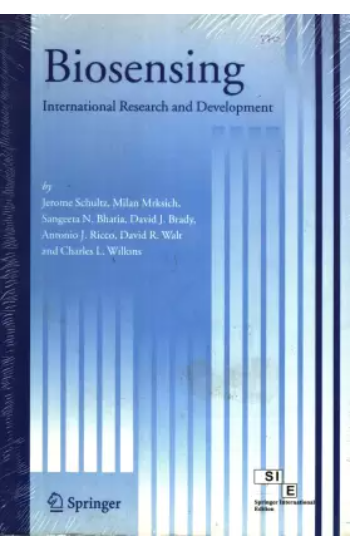
Save: 10%

Save: 15%
Biosensing International Research And Development
Publisher:
| Author:
| Language:
| Format:
Publisher:
Author:
Language:
Format:
₹699 ₹629
Save: 10%
In stock
Ships within:
In stock
ISBN:
Page Extent:
The goal of this book is to disseminate information on the worldwide status and trends in biosensing R&D to government decisionmakers and the research community. The contributors critically analyze and compare biosensing research in the United States with that being pursued in Japan, Europe and other major industrialized countries.
Biosensing includes systems that incorporate a variety of means, including electrical, electronic, and photonic devices; biological materials (e.g., tissue, enzymes, nucleic acids, etc.); and chemical analysis to produce detectable signals for the monitoring or identification of biological phenomena. In a broader sense, the study of biosensing includes any approach to detection of biological elements and the associated software or computer identification technologies (e.g., imaging) that identify biological characteristics. Biosensing is finding a growing number of applications in a wide variety of areas, including biomedicine, food production and processing, and detection of bacteria, viruses, and biological toxins for biowarfare defense. Subtopics likely to be covered in this study include the following: Nucleic acid sensors and DNA chips and arrays, organism- and cell-based biosensors, bioelectronics and biometrics, biointerfaces and biomaterials; biocompatibility and biofouling, integrated, multi-modality sensors and sensor networks, system issues, including signal transduction, data interpretation, and validation, novel sensing algorithms, e.g., non-enzyme-based sensors for glucose, mechanical sensors for prosthetics, related issues in bio-MEMS and NEMS (microelctromechanical and nanoelectromechanical systems), possibly including actuators, applications in biomedicine, the environment, food industry, security and defense.
Particular emphasis will be on technologies that may lead to portable or fieldable devices/instruments. Important consideration will be given to an integrated approach to detection, storage, analysis, validation, interpretation and presentation of results from the biosensing system. Focus will be on research from the following disciplines; BioMems & nano, optical spectroscopy, mass spectroscopy, chemometrics, pattern recognition, telemetry, signal processing, and toxicology.
The goal of this book is to disseminate information on the worldwide status and trends in biosensing R&D to government decisionmakers and the research community. The contributors critically analyze and compare biosensing research in the United States with that being pursued in Japan, Europe and other major industrialized countries.
Biosensing includes systems that incorporate a variety of means, including electrical, electronic, and photonic devices; biological materials (e.g., tissue, enzymes, nucleic acids, etc.); and chemical analysis to produce detectable signals for the monitoring or identification of biological phenomena. In a broader sense, the study of biosensing includes any approach to detection of biological elements and the associated software or computer identification technologies (e.g., imaging) that identify biological characteristics. Biosensing is finding a growing number of applications in a wide variety of areas, including biomedicine, food production and processing, and detection of bacteria, viruses, and biological toxins for biowarfare defense. Subtopics likely to be covered in this study include the following: Nucleic acid sensors and DNA chips and arrays, organism- and cell-based biosensors, bioelectronics and biometrics, biointerfaces and biomaterials; biocompatibility and biofouling, integrated, multi-modality sensors and sensor networks, system issues, including signal transduction, data interpretation, and validation, novel sensing algorithms, e.g., non-enzyme-based sensors for glucose, mechanical sensors for prosthetics, related issues in bio-MEMS and NEMS (microelctromechanical and nanoelectromechanical systems), possibly including actuators, applications in biomedicine, the environment, food industry, security and defense.
Particular emphasis will be on technologies that may lead to portable or fieldable devices/instruments. Important consideration will be given to an integrated approach to detection, storage, analysis, validation, interpretation and presentation of results from the biosensing system. Focus will be on research from the following disciplines; BioMems & nano, optical spectroscopy, mass spectroscopy, chemometrics, pattern recognition, telemetry, signal processing, and toxicology.
About Author
Reviews
There are no reviews yet.
Related products
Marine Mammal Physiology: Requisites For Ocean Living
Save: 15%
Essentials Of A Successful Biostatistical Collaboration
Save: 15%
RELATED PRODUCTS
Essentials Of A Successful Biostatistical Collaboration
Save: 15%
Introduction To Statistics For Biology Third Edition
Save: 15%
Marine Mammal Physiology: Requisites For Ocean Living
Save: 15%



Reviews
There are no reviews yet.